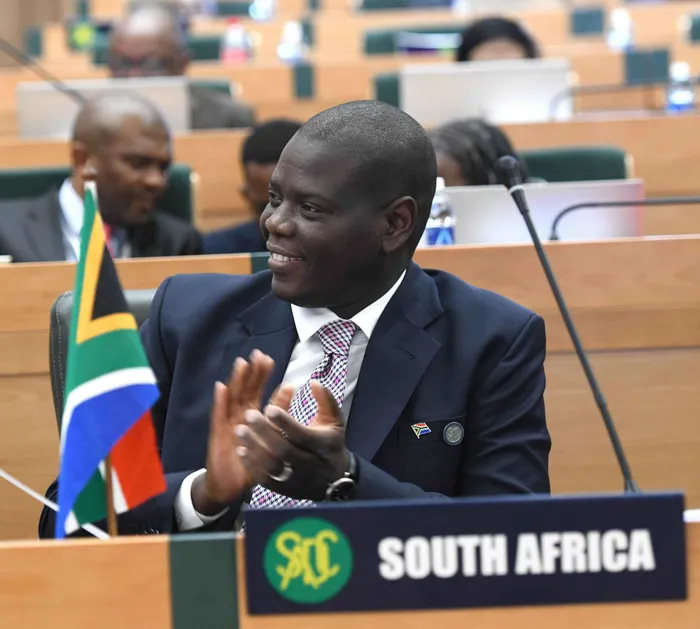Proposed regional parliament ‘a powerless subordinate’

Minister of International Relations and Co-operation Ronald Lamola at the SADC Ministerial Closing ceremony in Harare this week. The establishment of a parliamentary organ within the SADC structure is a step in the right direction as it will enhance the democratic and legitimacy credentials of the organisation. – Picture: Jacoline Schoonees / GCIS
By Sizo Nkala
On July 11 2024, the Democratic Republic of Congo (DRC) became the 12th Southern African Development Community (SADC) member-state to sign the Agreement Amending the SADC Treaty on the Transformation of the SADC Parliamentary Forum into a SADC Parliament thus reaching the quorum to bring the agreement into force.
SADC agreements require the assent of three quarters of the 16 member-states to come into force. The Agreement was adopted at the 42nd SADC Summit held in the DRC in 2022. This latest development means that work has to begin on the Protocol Establishing the SADC Parliament which will detail the structure, functions and power of the parliament.
SADC is a late comer to what some scholars have called the ‘parliamentarisation of regional organisations’ trend. Other regional organisations such as the Economic Community of West African States (Ecowas), the East African Community (EAC) and the Economic Community of Central African States (Eccas) established parliamentary organs in the late 1990s and early 2000s.
The continental body, the African Union (AU), established the Pan-African Parliament (PAP) in 2001. The SADC only managed to create a Parliamentary Forum in 1997 which is essentially an association of the region’s parliaments with no effective legislative powers.
Be that as it may, the establishment of a parliamentary organ within the SADC structure is a step in the right direction as it will enhance the democratic and legitimacy credentials of the organisation. As the representative of the people, the parliament will make the SADC more relevant to the people on the ground as they would have a voice in the working of the organisation.
The parliament will also improve accountability by holding the SADC executive structures to account for their decisions and also monitor the implementation of SADC treaties and agreements. Moreover, the establishment of a parliamentary organ will bring diverse voices to SADC. Currently, the organisation is dominated by the executives of the governments of member states who in most cases are drawn from the respective ruling parties.
Refreshingly, the parliament would also include parliamentarians from the minority parties who represent diverse voices in the member states. This will improve the inclusiveness of the organisation which has been dominated by the executives.
According to a draft protocol on the establishment of the parliament, the objectives of the regional parliament also include promoting human rights, speeding up the ratification of SADC treaties, promoting SADC inter-parliamentary co-operation, and making recommendations to the SADC Summit.
However, and worryingly, if the draft protocol is anything to go by, the new regional parliament will not have any legislative powers meaning that it will be devoid of the ability to make laws that are binding on all member states. Article 6 of the draft protocol says that the parliament will “develop Model Laws, including Model Laws as directed by the SADC Summit”.
Model Laws are not binding but are designed to guide member states in restructuring and reforming their domestic laws in line with the objectives of the particular Model Law. In addition, the Model Laws will only likely come into effect after the approval of the SADC Summit which makes the parliament a powerless subordinate of the executive.
Further undermining its influence is the absence of budgetary powers which will constrain its ability to hold the SADC institutions accountable. Thus, bereft of any legislative or budgetary powers, the impact of the regional parliament will be severely limited. Another crucial weakness is the manner in which the members of the parliament will be recruited.
The draft protocol says that members of the SADC parliament will be made up of five representatives from the national parliament of each member states which makes it an indirectly elected parliament. This follows the norm in other regional parliaments across Africa and the Pan-African Parliament, but it undermines the democratic credentials of the legislature.
Moreover, the composition of the parliament does not promote true representation in the sense that regardless of the fact that South Africa which has a population size over 60 times that of Swaziland’s will have the same number of representatives as the latter.
Such inherent weaknesses will hinder the effectiveness of the regional parliament. If the draft protocol is adopted at the SADC Summit in Harare and eventually comes into force, the organisation would have missed an opportunity build a truly democratic regional parliament that speaks for the citizens of the SADC region.
We have seen how the lack of legislative and budgetary powers in the Pan African Parliament has made it an institution of limited consequence in continental governance in its 20 years of existence.
Also indirectly elected, the PAP lacks the democratic mandate to speak on behalf of the African citizens. Barring any amendments to the draft protocol, the SADC seems to be on track to repeat the same mistake. While the regional parliament would be an improvement on the SADC Parliamentary Forum, it does not go far enough.
* Dr Sizo Nkala is a Research Fellow at the University of Johannesburg’s Centre for Africa-China Studies.
** The views expressed in this articles are the writer’s and do not necessarily reflect the views of The African